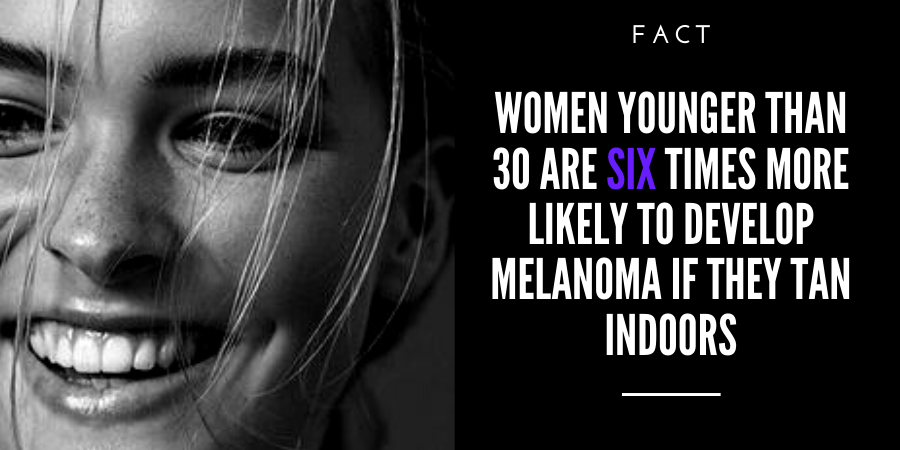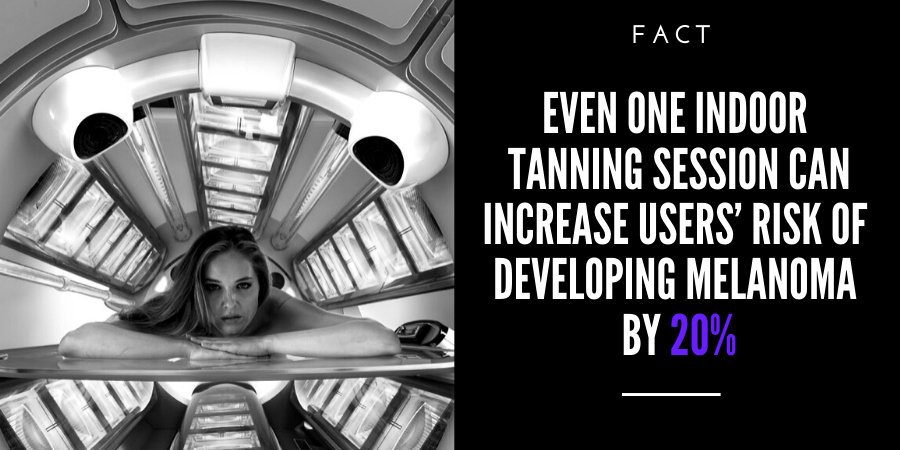What Are the Dangers of Indoor Tanning?
Studies have shown that the use of indoor tanning devices is associated with an increased risk of developing squamous cell carcinoma, basal cell carcinoma, and melanoma, the deadliest form of skin cancer. The use of tanning devices is also associated with melanoma of the eye, premature skin aging, and the development of cataracts.
Using indoor tanning beds and other indoor devices before the age of 35 substantially increases your risk of melanoma, and that risk increases with each use.1
The International Agency of Research on Cancer, a division of the World Health Organization, has declared ultraviolet (UV) radiation from artificial sources such as tanning beds and sun lamps as “carcinogenic to humans.” These devices were elevated to the highest cancer risk category, which includes other carcinogens such as radon, tobacco, and asbestos.2
Myths About Indoor Tanning
For many years, the tanning industry has promoted tanning devices as a safe alternative to the natural sun, which leads to a lot of misleading and incorrect information believed by the general public. Despite a large amount of data that connects indoor tanning to skin cancer, the most damaging myth is that indoor tanning does not cause skin cancer. It does. Indoor tanning is linked to melanoma, basal cell carcinoma, and squamous cell skin cancer. Using tanning beds before age 20 can increase your chances of developing melanoma by 47%, and the risk increases with each use.3

Researchers have estimated that 11,374 cases of melanoma each year are attributable to indoor tanning.4 The younger a person starts indoor tanning, the higher his/her risk. Those who begin tanning before the age of 35 substantially increase their melanoma risk, and that risk continues to increase with each subsequent use.1,5 Women younger than 30 are six times more likely to develop melanoma if they tan indoors.6
Many believe using a tanning bed to get a ‘base tan’ prevents later sunburns. A “base tan”—whether from a tanning bed or the sun—does not prevent sunburns. Research suggests that a base tan might offer a person an SPF rating of between 1 and 3—a nearly useless amount of SPF.7,8 More importantly, it’s critical to remember that a tan itself is an indicator of DNA damage from UV rays, just as a sunburn is. Damaged DNA—whether because of sunburn or tan, and whether resulting from the sun or a tanning bed—causes mutations in the skin cells that can result in melanoma and other skin cancers.

Another myth is that indoor tanning is safer than outdoor tanning. It is not safer than outdoor tanning, and it appears to be even more dangerous. The amount of radiation produced during indoor tanning is similar to the sun, and in some cases, may emit UV radiation up to 15 times the strength of the midday summer sun.9,10 Indoor tanning often involves prolonged and intense exposure to UV radiation unlike natural sunlight, which varies throughout the day and can be shielded by clouds or shade. Tanning beds continuously emit concentrated levels of UV rays. This constant bombardment of high-intensity radiation significantly increases the risk of developing skin cancer. Furthermore, frequent indoor tanners usually start at a young age when their skin is more vulnerable to damage. Adolescents and young adults who engage in indoor tanning are particularly susceptible to developing melanoma – the deadliest form of skin cancer.
Finally, some people believe that indoor tanning is an excellent source of vitamin D. It is not. Tanning beds and other indoor tanning devices mainly emit UVA rays. It is UVB rays that interact with a protein in the skin to convert it into vitamin D. And most people get enough vitamin D from incidental sun exposure in just a few minutes a day. For those who are vitamin D deficient, the medical community recommends getting vitamin D from a healthy diet that includes foods and beverages naturally rich in vitamin D and/or vitamin D supplements.

Indoor Tanning Facts & Statistics
- More people develop skin cancer because of indoor tanning than develop lung cancer because of smoking.12
- Individuals who have used tanning devices 10 or more times in their lives have a 34% increased risk of developing melanoma compared to those who have never used tanning devices.13
- Those who begin tanning before the age of 35 increase their melanoma risk by 59 percent, and the risk increases with each use.1,2
- Women younger than 30 are six times more likely to develop melanoma if they tan indoors. At all ages, the more women tan indoors, the higher their risk of developing melanoma.6
- Any history of indoor tanning increases the risk of developing basal cell carcinoma before age 40 by 69 percent.14
- Approximately 7.8 million adult women and 1.9 million adult men in the United States tan indoors.15
- Thirty-five percent of American adults, 59 percent of college students, and 17 percent of teens have reported using a tanning device in their lifetime.16
- Nearly 70 percent of tanning salon customers are Caucasian girls and women, primarily between the ages of 15 to 29.17,18
- Research indicates that more than half of indoor tanners (52.5 percent) start tanning before the of age 21. More than forty-four percent of those who started tanning before age 16 reported they did so with a family member. Forty-nine percent of those who started tanning with a family member did so with their mother.19
- A recent study found that 6.7 percent of indoor tanners reported having been burned by a tanning machine.20
- In a 2009 study, 58 percent of adolescent tanning bed users had burns due to frequent exposure to indoor tanning beds/lamps.21
- An estimated 3,234 indoor tanning-related injuries were treated each year in US hospital emergency departments from 2003 to 2012.22
- The estimated cost of treating skin cancers attributable to indoor tanning is $343.1 million a year, leading to a total economic loss of $127.3 billion over the lifetime of those affected.23
Regulations Governing the Use of Tanning Devices
The World Health Organization, the U.S. Food & Drug Administration, National Cancer Institute, American Medical Association, and American Academy of Dermatology all recommend that no one under the age of 18 use a tanning device.
In the United States, only 20 states and the District of Columbia completely ban the use of tanning devices for those under the age of 18. Two states allow minors to use tanning devices with a doctor’s prescription. Many states have some form of restrictions for minors, which range from parental permission to a partial ban, or combination thereof.
Brazil and Australia have passed complete bans for all of their citizens on indoor tanning. France, Spain, Portugal, Germany, Austria, Belgium, the United Kingdom, Iceland, Italy, Finland, Norway, and parts of Canada prohibit indoor tanning for youth under age 18.
Referencias:
(1) Autier P. Perspectives in melanoma prevention: the case of sunbeds. Eur J Cancer. 2004;40(16):2367–2376.
(2) Boniol M, Autier P, Boyle P, Gandini S. Cutaneous melanoma attributable to sunbed use: systematic review and meta-analysis. BMJ. 2012;345:e4757.
(3) Guy GP, Berkowitz Z, Holman D and Hartman A. Recent Changes in the Prevalence and Factors Associated With Frequency of Indoor Tanning Among U.S. Adults. JAMA Dermatol 2015; Published online July 1, 2015.
(4) Wehner MR, Chren M, Nameth D, et al. International Prevalence of Indoor Tanning: A Systematic Review and Meta-analysis.JAMA Dermatol. 2014;150 (4): 390-400. doi:10.1001/jamadermatol.2013.6896.
(5) Choi, K., Lazovich, D., Southwell, B., Forster, J., Rolnick, S. J., and Jackson, J. Prevalence and characteristics of indoor tanning use among men and women in the United States. Archives of Dermatology, Vol. 146 2010, No. 12, pp. 1356-61.
(6) NAACCR Fast Stats: An interactive tool for quick access to key NAACCR cancer statistics. North American Association of Central Cancer Registries. http://www.naaccr.org/. (Accessed on 3-10-2016)
(7) Kann L, McManus T, Harris WA, et al. Youth Risk Behavior Surveillance — United States, 2015. MMWR Surveill Summ 2016;65(No. SS-6):1–174. DOI: http://dx.doi.org/10.15585/mmwr.ss6506a1.
(8) Watson M, Shoemaker M, Baker K. Indoor Tanning Initiation Among Tanners in the United States. JAMA Dermatol. Published online March 22, 2017. doi:10.1001/jamadermatol.2016.5898.
(9) U.S. Department of Health and Human Services, Public Health Service, National Toxicology Program. Report on Carcinogens, 11th ed: Exposure to Sunlamps or Sunbeds.
(10) Ogden N. General and Plastic Surgery Devices: Reclassification of Ultraviolet Lamps for Tanning, Henceforth To Be Known as Sunlamp Products and Ultraviolet Lamps Intended for Use in Sunlamp Products.https://www.federalregister.gov/articles/2014/06/02/2014-12546/general-and-plastic-surgery-devices-reclassification-of-ultraviolet-lamps-for-tanning-henceforth-to Accessed June 9, 2014.
(11) Boniol B, Autier P, Boyle P, Gandini S. “Cutaneous melanoma attributable to sunbed use: systematic review and meta-analysis”. British Medical Journal, 2012; 345:e4757. Correction published December 2012; 345:e8503.
(12) The International Agency for Research on Cancer Working Group on artificial ultraviolet (UV) light and skin cancer “The association of use of sunbeds with cutaneous malignant melanoma and other skin cancers: A systematic review.” International Journal of Cancer. 2007 March 1;120:111-1122.
(13) Cust AE, Armstrong BK, Goumas C, Jenkins MA, Schmid H, Hopper JL, Kefford, RF et al. Sunbed Use During Adolescence and Early Adulthood is Associated with Increased Risk of Early-Onset Melanoma. Int Journal of Cancer. 2011 May 1:128(10):2425-35.
(14) Lazovich D, et al. Association Between Indoor Tanning and Melanoma in Younger Men and Women. JAMA Dermtol. 2016; 152(3):268-275. doi:10.1001/jamadermatol.2015.2938.
(15) Piepkorn M. Melanoma Genetics: An Update With Focus on the CDKN2A(p16)/ARF Tumor Suppressors. J. Am Acad Dermatol. 2000 May;42(5 Pt 1):705-22; quiz 723-6.
(16) Vajdic CM, Kricker A, Giblin M, McKenzie J, Aitken JF, Giles GG, Armstrong BK. Artificial Ultraviolet Radiation and Ocular Melanoma in Australia. Int J Cancer. 2004 Dec 10;112(5):896-900.
(17) Walters BL, Kelly TM. Commerical Tanning Facilities: A New Source of Eye Injury. Am J Emerg Med 1987;120:767-77.
(18) Clingen PH, Berneburg M. Petit=Frere C, Woollons A, Lowe JE, Arlett CF, Green MH. Contrasting Effects of an Ultraviolet B and an Ultraviolet A Tanning Lamp on Interleukin-6. Tumour Necrosis Factor-Alpha and Intercellurlar Adhesion Molecule-1 Expression. Br J Dermatol. 2001 Jul;145(1):54-62.
(19) Karagas MR, Stannard VA, Mott LA, Slattery MJ, Spencer SK, Weinstock MA. Use of Tanning Devices and Risk of Basel Cell Squamous Cell Skin Cancers. J Natl Cancer Inst 2002;94:224-6.
(20) Colantonio S, Bracken MB, Beecker J. The association of indoor tanning and melanoma in adults: systematic review and meta-analysis. J Am Acad Dermatol 2014; 70(5):847-857.e1-118. doi: 10.1016/j.jaad.2013.11.050. Epub 2014 Mar 12.
(21) Wehner MR, Chren M, Nameth D, et al. International prevalence of indoor tanning: a systematic review and meta-analysis. JAMA Dermatol. 2014;150(4):390-400.
(22) Wehner M, Chren M-M, Nameth D, et al. International prevalence of indoor tanning: a systematic review and meta-analysis. JAMA Dermatol 2014; 150(4):390-400. Doi: 10.1001/jamadermatol.2013.6896.
(23) Cokkinides V, Weinstock MA, Lazovich D, Ward E, Thun M. Indoor Tanning Use Among Adolescents in the US, 1998-2004. Cancer 2009:115:190-98.
(24) Guy G, et al. JAMA Internal Medicine Published online December 15, 2014.
(25) Gery P. Guy Jr., et al. Trends in Indoor Tanning and Its Association with Sunburn Among US Adults. J. Dermatol. 2017 June;76(6):1191-93.
(26) Waters HR and Adamson A. The health and economic implications of using tanning devices. J Cancer Policy. 2016.
http://dx.doi.org/10.1016/j.jcpo.2016.12.003.
